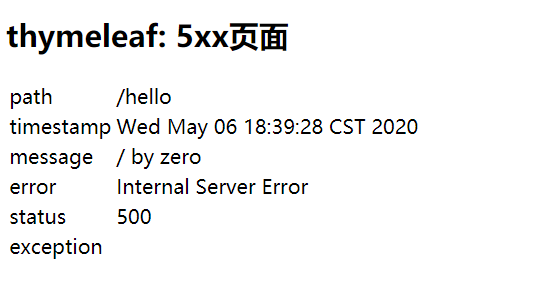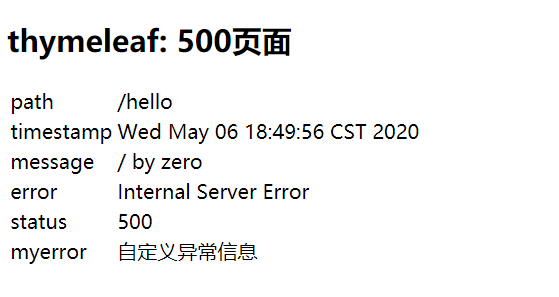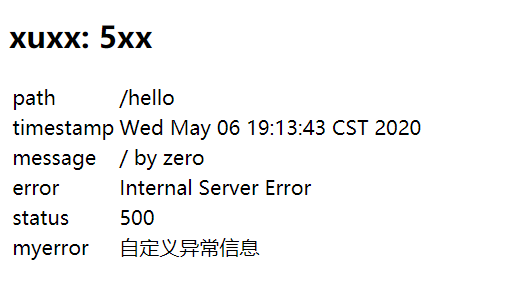Spring Boot中的自定义异常处理
1. Spring Boot实现自定义错误页
演示
@RestController
public class HelloController {
@GetMapping("/hello")
public String hello() {
int i = 1 / 0;
return "hello";
}
}
访问结果

配置默认的error页面
在src\main\resources\static目录下创建error目录,创建如:404.HTML,500.HTML
<!DOCTYPE html>
<html lang="en">
<head>
<meta charset="UTF-8">
<title>404</title>
</head>
<body>
<h2>404错误页面</h2>
</body>
</html>
--------------------------------
<!DOCTYPE html>
<html lang="en">
<head>
<meta charset="UTF-8">
<title>500</title>
</head>
<body>
<h2>500错误页面</h2>
</body>
</html>
再次访问便会看到500.HTML中的内容(Controller中有int i = 1 / 0);如果访问http://localhost:8080/hello2等会出现404错误的路径便会看到404.HTML的内容。
即Spring Boot会根据状态码去寻找对应的页面来替换其默认的错误页。
错误页面查找顺序:精确>模糊,动态>静态
使用Spring时,后端出现错误时,在前端的报错提示对用户来说相当不友好,所以应该对异常进行处理,但是对每一个Controller单独进行处理过于重复,所以可以使用@ControllerAdvice处理全局异常。
当然,如果定义了404.HTML和4xx.HTML页面,出现404错误时,Spring Boot会优先展示404.HTML的内容。
以上都是使用静态页面(static目录下)展示错误信息,但是Spring Boot还支持动态页面(templates目录下),如:thymeleaf、freemarker。
测试一下,使用thymeleaf来自定义错误页面
导入thymeleaf依赖
<dependency> <groupId>org.springframework.boot</groupId> <artifactId>spring-boot-starter-thymeleaf</artifactId> </dependency>
在
src\main\resources\templates目录下创建error目录,并创建自定义错误页创建如下3个页面
<!--4xx.HTML--> <!DOCTYPE html> <html lang="en"> <head> <meta charset="UTF-8"> <title>4xx</title> </head> <body> <h2>thymeleaf:4xx页面</h2> </body> </html> ------------------------------------- <!--404.HTML--> <!DOCTYPE html> <html lang="en"> <head> <meta charset="UTF-8"> <title>404</title> </head> <body> <h2>thymeleaf:404页面</h2> </body> </html> ------------------------------------- <!--5xx.HTML--> <!DOCTYPE html> <html lang="en" xmlns:th="http://www.thymeleaf.org"> <head> <meta charset="UTF-8"> <title>5xx</title> </head> <body> <h2>thymeleaf: 5xx页面</h2> </body> </html>
与静态错误页一样,动态错误页也是优先展示更为精确的状态码所对应的错误页内容。
例:在存在以上3个动态错误页时,如果出现
404错误,优先展示的也是404.HTML的内容。此时已经创建了静态错误页和动态错误页,那么此时会优先展示动态错误页。
2. Spring Boot异常处理源码分析
打开Spring Boot异常处理的自动配置类org.springframework.boot.autoconfigure.web.servlet.error.ErrorMvcAutoConfiguration
其中配置了DefaultErrorAttributes(默认错误属性)、DefaultErrorViewResolver(默认错误视图解析器)等等
为什么在error目录下创建自定义错误页会被解析呢?
为什么错误页面查找顺序:精确>模糊,动态>静态 呢?
答案在DefaultErrorViewResolver类中。
//DefaultErrorViewResolver类
@Override
public ModelAndView resolveErrorView(HttpServletRequest request, HttpStatus status, Map<String, Object> model) {
//status.value()返回的是int类型的状态码,model是异常数据
ModelAndView modelAndView = resolve(String.valueOf(status.value()), model);
//在静态资源路径下没有找到精确对应的错误页面时再判断是否存在模糊对应的错误页面
//SERIES_VIEWS中只有"4xx"和"5xx"
if (modelAndView == null && SERIES_VIEWS.containsKey(status.series())) {
//存在模糊对应的错误页面时,再次使用模糊的状态码进行处理
modelAndView = resolve(SERIES_VIEWS.get(status.series()), model);
}
//如果精确的和模糊的错误页都不存在,便使用自身默认的错误页面
return modelAndView;
}
...
private ModelAndView resolve(String viewName, Map<String, Object> model) {
String errorViewName = "error/" + viewName;
//判断是否存在动态页面
TemplateAvailabilityProvider provider = this.templateAvailabilityProviders.getProvider(errorViewName,
this.applicationContext);
//存在动态页面就优先使用动态页面
if (provider != null) {
return new ModelAndView(errorViewName, model);
}
return resolveResource(errorViewName, model);
}
private ModelAndView resolveResource(String viewName, Map<String, Object> model) {
for (String location : this.resourceProperties.getStaticLocations()) {
try {
//查找静态资源路径 4个
/*{ "classpath:/META-INF/resources/",
"classpath:/resources/", "classpath:/static/", "classpath:/public/" }*/
Resource resource = this.applicationContext.getResource(location);
resource = resource.createRelative(viewName + ".html");
if (resource.exists()) {
return new ModelAndView(new HtmlResourceView(resource), model);
}
}
catch (Exception ex) {
}
}
//在静态资源路径下没有找到对应的错误页面就返回null
return null;
}
3. Spring Boot自定义异常数据
经过查看Spring Boot异常处理的自动配置类org.springframework.boot.autoconfigure.web.servlet.error.ErrorMvcAutoConfiguration可知DefaultErrorAttributes类中定义了默认的异常数据处理逻辑。
包含了以下异常数据:
timestamp - The time that the errors were extracted(出现错误的时间)
status - The status code(状态码)
error - The error reason(错误原因)
exception - The class name of the root exception (if configured)(根异常的类名(如果已配置))
message - The exception message(异常消息)
errors - Any ObjectErrors from a BindingResult exception(BindingResult异常中的任何ObjectError)
trace - The exception stack trace(异常堆栈跟踪)
path - The URL path when the exception was raised(引发异常时的URL路径)编写自定义错误页5xx.HTML来查看
<!DOCTYPE html>
<html lang="en" xmlns:th="http://www.thymeleaf.org">
<head>
<meta charset="UTF-8">
<title>5xx</title>
</head>
<body>
<h2>thymeleaf: 5xx页面</h2>
<table>
<tr>
<td>path</td>
<td th:text="${path}"></td>
</tr>
<tr>
<td>timestamp</td>
<td th:text="${timestamp}"></td>
</tr>
<tr>
<td>message</td>
<td th:text="${message}"></td>
</tr>
<tr>
<td>error</td>
<td th:text="${error}"></td>
</tr>
<tr>
<td>status</td>
<td th:text="${status}"></td>
</tr>
<tr>
<td>exception</td>
<td th:text="${exception}"></td>
</tr>
</table>
</body>
</html>
访问结果:(访问的Controller中有by zero错误)

为了自定义异常数据,可以直接继承DefaultErrorAttributes类,然后新增或重写其方法。
/* 注册到spring以替换DefaultErrorAttributes
ErrorMvcAutoConfiguration中有条件判断:当存在ErrorAttributes.class(DefaultErrorAttributes实现的接口)时,DefaultErrorAttributes不生效.
...
@ConditionalOnMissingBean(value = ErrorAttributes.class, search = SearchStrategy.CURRENT)
public DefaultErrorAttributes errorAttributes() {
return new DefaultErrorAttributes(this.serverProperties.getError().isIncludeException());
}
*/
@Component
public class MyErrorAttribute extends DefaultErrorAttributes {
@Override
public Map<String, Object> getErrorAttributes(WebRequest webRequest, boolean includeStackTrace) {
//拿到DefaultErrorAttributes类中收集好的异常信息
Map<String, Object> map = super.getErrorAttributes(webRequest, includeStackTrace);
//添加自定义异常信息
map.put("myerror", "自定义异常信息");
return map;
}
在5xx.HTML中添加一列
...
<h2>thymeleaf: 500页面</h2>
...
<tr>
<td>myerror</td>
<td th:text="${myerror}"></td>
</tr>
...
访问结果:(访问的Controller中有by zero错误)

4. Spring Boot自定义异常视图
与自定义异常数据类似,Spring Boot异常处理的自动配置类org.springframework.boot.autoconfigure.web.servlet.error.ErrorMvcAutoConfiguration中定义了DefaultErrorViewResolver类中用于异常视图处理。要自定义异常视图处理,继承DefaultErrorViewResolver类,然后新增或重写其方法就行了。
@Component
public class MyErrorViewResolver extends DefaultErrorViewResolver {
public MyErrorViewResolver(ApplicationContext applicationContext, ResourceProperties resourceProperties) {
super(applicationContext, resourceProperties);
}
@Override
public ModelAndView resolveErrorView(HttpServletRequest request, HttpStatus status, Map<String, Object> model) {
//这里的model就是异常数据,但是它是一个不可修改的map,要在这修改可以new一个map,将model的数据复制进来再添加到mv返回
ModelAndView mv = new ModelAndView();
mv.setViewName("xuxx");
mv.addAllObjects(model);
return mv;
}
}
新建xuxx.HTML直接放在src\main\resources\templates目录下即可(因为自定义的MyErrorViewResolver中设置的ViewName不带路径了,又因为是用thymeleaf)
<!DOCTYPE html>
<html lang="en" xmlns:th="http://www.thymeleaf.org">
<head>
<meta charset="UTF-8">
<title>xuxx页面</title>
</head>
<body>
<h2>xuxx: 5xx</h2>
<table>
<tr>
<td>path</td>
<td th:text="${path}"></td>
</tr>
<tr>
<td>timestamp</td>
<td th:text="${timestamp}"></td>
</tr>
<tr>
<td>message</td>
<td th:text="${message}"></td>
</tr>
<tr>
<td>error</td>
<td th:text="${error}"></td>
</tr>
<tr>
<td>status</td>
<td th:text="${status}"></td>
</tr>
<tr>
<td>myerror</td>
<td th:text="${myerror}"></td>
</tr>
</table>
</body>
</html>访问结果:
